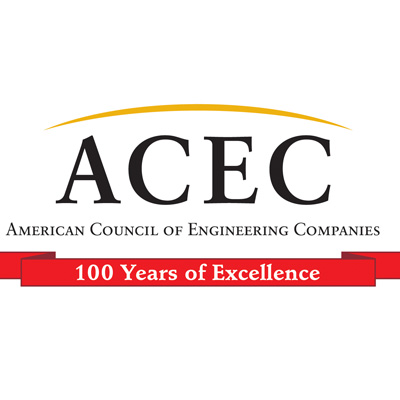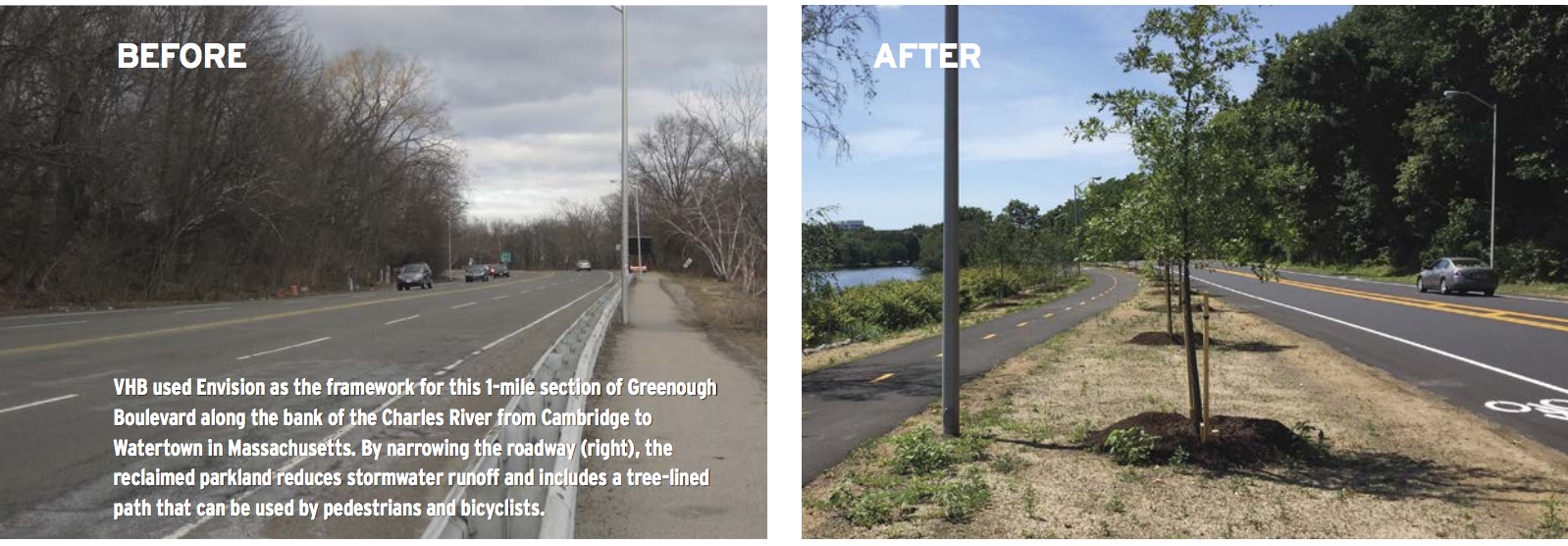AMERICAN COUNCIL OF ENGINEERING COMPANIES (ACEC)
Written by Bob Woods
The inclusion of sustainability in infrastructure design is hardly a new concept in the engineering world. What city or firm wouldn’t want a highway or bridge to hold up for a long time? But the emphasis on pairing the two has recently turned into a top priority and a hot topic. Sustainable infrastructure was the focus of Envision, introduced in 2012 as a new rating system to promote best practices in planning, designing, building and maintaining public roads, bridges, tunnels, water systems and other civic entities. The program was created by the aptly named Institute for Sustainable Infrastructure (ISI), a nonprofit organization jointly founded a year earlier by ACEC, the American Society of Civil Engineers (ASCE) and the American Public Works Association (APWA). ISI also collaborated with the Zofnass Program for Sustainable Infrastructure at the Harvard University Graduate School of Design to develop Envision.
The Envision rating system addresses a full range of environmental, social and economic impacts of sustainability in project design, construction and operation. Labeled “credits,” these impacts are classified under five categories: quality of life, leadership, resource allocation, natural world, and climate and risk.
Completed projects are evaluated by ISI and recognized for their credit achievement levels with either bronze, silver, gold or platinum honors.
During its first four years, Envision has been employed to enhance hundreds of infrastructure projects—primarily in the U.S., ISI says—and nearly 5,000 engineering practitioners have added the system to their skill set by earning the Envision Sustainability Professional accreditation (ENV SP). As with any new way of doing things, however, acceptance has been incremental.
“First, people needed to get educated on how they can use Envision,” says Denise Nelson, ISI’s vice president for public education. “Then they needed to use it to see for themselves how it could impact their projects.” ISI had initially considered making certain credits mandatory but dropped that idea in order to make Envision flexible and adaptable, she adds. The primary goal, regardless of how many credits are pursued, is to incrementally increase the sustainability of a project.
The Standard Language
At the same time, a growing number of ACEC Member Firms are communicating their experience with Envision as a way to differentiate themselves when dealing with cities and other infrastructure owners—an increasing number of which are incorporating sustainability into their projects.
“Many of those firms were creating proprietary tools to quantify their sustainability, but communities couldn’t compare one to the other,” Nelson says. “Now, Envision can be the standard language.” In fact, some communities are asking for Envision in their RFPs and inquiring whether firms have ENV SPs on staff and whether they’ve used the system on projects, she adds. It’s no coincidence that ACEC Member Firms are not only promoting their sustainability credentials but also embracing Envision as a universal guideline.
“The idea of sustainability is embedded in who we are as a company but also in the work we’re doing,” says Ifetayo Venner, global leader, water supply and treatment, at Arcadis U.S., the Denver, Colorado-based unit of the Dutch parent. “Our clients are demanding it to help them develop sustainable solutions.”
Arcadis, which is on the advisory board of the Zofnass Program, became a charter member of ISI. When Envision was launched, the firm was among several companies that committed to train and credential at least 100 ENV SPs within the year, a figure that stands at around 130 people. “We see the value of having people trained so they know how to think differently as they’re doing their designs,” Venner says. “Most learn a more traditional approach in school, but we want them to consider factors such as how the project may impact a community and use less resources.”
Venner is currently working on three wastewater projects utilizing Envision, one of them for New York City’s Department of Design and Construction. “They are currently constructing a stormwater wetland for the New York City Department of Environmental Protection, as part of the Staten Island Bluebelt system to more sustainably manage stormwater and alleviate flooding using green infrastructure,” she says. In the wake of Hurricane Sandy, New York City made sustainability a prime objective. “Both agencies want to use Envision as a tool to ensure that their projects are more sustainable,” Venner says.
Envision at Work
Los Angeles, California-based Psomas was another original adopter of Envision, with Tim Psomas, son of the firm’s founder, serving as the first chairman of the ISI board. “Our commitment to Envision starts at the top and filters down,” says Kevin Thornton, a senior project manager and director of sustainability at Psomas, which has trained more than 150 employees for ENV SP designation. “We want staff at the project engineer level and above to be certified.” Before Envision, Psomas encouraged its practitioners to attain LEED certification, which helped employees think about sustainability, Thornton says.
The strategy has paid off, as Psomas has already earned an Envision platinum award for a water project in Los Angeles County. The South Los Angeles Wetland Park, completed in 2013, is a 9-acre, multipurpose public nature park and sustainable stormwater treatment wetland constructed on a former transportation authority brownfield redevelopment site. Last year, Psomas was also selected as the prime consultant on the Rory M. Shaw Wetlands Park, one of several projects within Los Angeles County’s Sun Valley Watershed Management Plan, which recently received an Envision platinum award.
At Watertown, Massachusetts-based VHB, introducing Envision across its network of 23 offices and 1,250 professionals has provided a platform for internal education, says Kari Hewitt, director of sustainability and leader of the effort. “We have a generational company philosophy, so part of our culture is to foster the growth and development of our younger people so that they take on leadership roles in the future,” she says. “Our sustainability efforts are reflective of this philosophy as well—that we should invest in our people in a meaningful way so that our company and our communities are continuously improving.”
The younger generation is generally more attuned to environmental and social issues, so they’re excited about Envision, Hewitt says. “That energy has been infectious in getting our midand upper-level leaders who’ve been with the company a long time to think of new ways to approach their projects,” she says.
VHB’s integrated teams of civil engineers, environmental scientists, planners, water resource engineers and other professionals have to come together to think outside their individual disciplines in order to create effective solutions for clients, she says. “Envision brought a new framework and set of best practices, forcing us to look across socioeconomic and environmental issues in infrastructure projects,” Hewitt says. By last August, VHB had trained and certified 114 ENV SPs.
VHB has used Envision for guidance and a framework on numerous infrastructure projects, and clients at transit agencies, local governments and even private developers have been referencing the system in discussions and proposals, Hewitt says. “We’re seeing increasing questions about sustainability, and Envision is a tool we can bring to the table and say, ‘Here’s a clear and transparent system we can apply to your project to help you achieve your sustainability goals.’ And that can be a real differentiator for winning projects.”
One project where VHB has utilized the system involved redevelopment of a 1-mile section of Greenough Boulevard in Watertown and Cambridge, Massachusetts, which stretches along the west bank of the Charles River. By narrowing the roadway, the public-private Greenough Greenway Project has reclaimed riverside parkland and established a tree-lined path for pedestrians and bicyclists, reducing stormwater runoff as well. “The project is currently being verified for an Envision award,” Hewitt says.
Download full article (PDF): Setting the Standard
Download latest issue of ACEC’s Engineering, Inc.
 About the American Council of Engineering Companies
About the American Council of Engineering Companies
www.acec.org
The American Council of Engineering Companies (ACEC) is the voice of America’s engineering industry. Council members – numbering more than 5,000 firms representing more than 500,000 employees throughout the country – are engaged in a wide range of engineering works that propel the nation’s economy, and enhance and safeguard America’s quality of life. These works allow Americans to drink clean water, enjoy a healthy life, take advantage of new technologies, and travel safely and efficiently. The Council’s mission is to contribute to America’s prosperity and welfare by advancing the business interests of member firms.
Tags: ACEC, American Council of Engineering Companies, Bob Woods, Engineering, Engineering Inc., Envision, Institute for Sustainable Infrastructure, ISI







 RSS Feed
RSS Feed